Key Factors to Consider When Buying an Engagement Ring
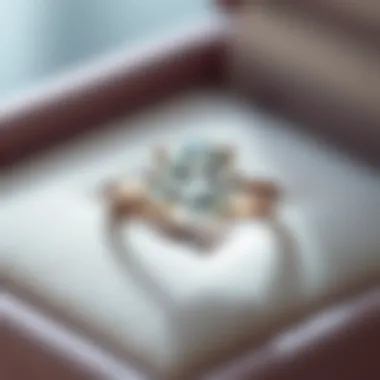

Intro
Purchasing an engagement ring is no small feat. It’s a task that evokes a whirl of emotions and decisions, making it both thrilling and, at times, a bit daunting. Diving into the world of engagement rings involves not just picking a shiny stone but understanding the nuances that make up this important milestone. From selecting the right metal to choosing a sparkling gemstone that symbolizes love and commitment, every choice counts. This guide is crafted to illuminate the essential aspects of this journey, paving the way for an informed decision that resonates with both heart and budget.
Overview of Gemstones and Minerals
Engagement rings often center around gemstones, particularly diamonds, and there is much to know. Gemstones are more than just pretty pieces. They have ancient origins and continue to hold significant meaning in various cultures.
History of Gemstone and Mineral Use
Historically, gemstones have captured the human imagination. In ancient times, cultures regarded them as symbols of power, wealth, and protection. For example, in ancient Egypt, lapis lazuli was not just a valued gemstone but also believed to hold mystical properties. The Greeks associated certain stones with their gods. So, while choosing a gemstone, remember that there’s history wrapped around those sparkling pieces.
Significance in Culture and Society
In today’s world, gemstones still retain cultural importance. For instance, sapphires are frequently linked to royalty, while rubies symbolize love and passion. Different cultures celebrate specific stones; in some traditions, certain stones are thought to bring prosperity or happiness. This adds another layer of meaning when selecting the perfect gem for that special someone, as it connects personal sentiment to broader societal beliefs.
Gemstone Formation and Properties
Understanding how gemstones are formed can deepen your appreciation for their beauty.
Formation Process of Gemstones
Gemstones originate from the Earth’s crust, subjected to high pressure and temperature over millennia. For example, diamonds, forming deep within the Earth’s mantle, take over a billion years to develop. This process not only affects their appearance but also their value.
Properties that Define Gemstones
When evaluating a gemstone, consider its properties: color, clarity, cut, and carat weight, often referred to as the "Four Cs" for diamonds. For colored gemstones, tone, saturation, and hue also come into play. Each characteristic contributes to the overall beauty and desirability of the stone.
Classification based on Color, Hardness, and Luster
Gemstones are also categorized based on their physical properties. For instance, the Mohs scale of hardness, which rates hardness from 1 (talc) to 10 (diamond), helps buyers understand durability. Additionally, luster describes how light interacts with the surface of the stone, categorized into types like metallic, vitreous, or pearly. Knowing these classifications can help in selecting a gem that lasts a lifetime.
Types of Gemstones
The variety of gemstones available is vast, and not every gemstone possesses the same value or significance.
Precious vs. Semi-Precious Gemstones
Gemstones are typically divided into two groups: precious and semi-precious. Precious stones include diamonds, rubies, emeralds, and sapphires, noted for their rarity and high value. Semi-precious stones, like amethyst or aquamarine, while beautiful, are generally more abundant and affordable.
Common Gemstone Varieties
Among the crowd of gemstones, diamonds often take center stage for engagement rings; however, there are other striking options worth considering. For instance, morganite has gained popularity for its soft pink hues, while blue sapphires and emeralds bring a vibrant touch. These alternatives not only provide uniqueness but often come with a lesser price tag.
Exotic and Rare Gemstones
For those seeking something out of the ordinary, exotic gemstones such as tanzanite or alexandrite can provide a distinctive touch. Tanzanite, found only in Tanzania, showcases a mesmerizing blue-violet color, making it an elegant option. Meanwhile, alexandrite, known for its color-changing properties, offers a striking surprise.
Identifying and Evaluating Gemstones
Gemstone evaluations may appear complex; however, understanding the fundamentals can simplify the process.
Factors Affecting Gemstone Value
Several factors can affect a gemstone's value. Rarity, craftsmanship, market demand, and historic significance all contribute to pricing. Condition matters too; damage or inclusions can reduce value, so ensuring the gem is in the best possible state is crucial.
Techniques for Gemstone Identification
Gemstone identification involves examining cuts, colors, and potential synthetics. Sophisticated tools like a refractometer or a spectroscope can help distinguish genuine stones from imitations. If you're not confident in this area, consider consulting a professional gemologist.
Assessing Gemstone Quality
When assessing quality, always keep an eye out for clarity, color intensity, and carat size. High-quality stones should exhibit powerful colors and minimal inclusions. Taking time to evaluate these elements makes a difference when it comes to choosing a lasting piece.
Caring for Gemstones
Even after successfully picking a gemstone, responsible care is essential to ensure its longevity.
Cleaning and Storing Gemstones Properly
To preserve their beauty, cleaning should be done with care. Generally, a soft cloth and mild soapy water will do the trick for most stones. Storing them separately in a soft pouch or box prevents scratches is equally important.
Avoiding Common Mistakes in Gemstone Care
Avoid exposing your gemstones to harsh chemicals or extreme temperature changes, as these can cause damage. Also, make a habit of removing rings during chores or physical activities to prevent unintentional wear.
Preservation Tips for Specific Gem Types
Each gemstone might require unique care. For example, pearls should avoid exposure to perfumes, while harder stones like diamonds can be cleaned with ultrasonic cleaners. Researching each type’s distinct needs is vital for preserving their natural beauty.
Understanding the Significance of an Engagement Ring
An engagement ring is far more than just a piece of jewelry; it carries with it a plethora of emotions and historical context. Purchasing an engagement ring is a venture steeped in tradition and personal significance. Understanding what these rings mean not only aids in making informed choices but also in appreciating the journey of love they represent.
Historical Context
The origins of the engagement ring can be traced back to ancient civilizations. In Roman times, it was common for women to wear rings made of iron as a symbol of their betrothal—a reflection of the durability and strength that the union was meant to signify. This transitioned into the more romantic tradition of using gold and gemstones, with diamonds being introduced in the 15th century when the Archduke Maximilian of Austria presented one to Mary of Burgundy.
Fast forward to modern times, the engagement ring has evolved into a cultural icon laden with meaning. It signifies commitment, loyalty, and a promise of a shared future. The diamond, which has become the quintessential choice for most couples, came to be associated with perpetual love and endurance primarily through marketing efforts in the early 20th century. This historical journey reminds buyers that every ring tells a story, woven through time and tradition.
Cultural Variations
Engagement rings vary widely across cultures, each bearing its own unique significance. In some cultures, like Indian tradition, it’s common to see elaborate rings adorned with colorful gemstones, symbolizing various aspects of life and love. Conversely, in Scandinavian countries, simpler metal bands are often used, emphasizing practicality over extravagance.
Additionally, in many Western cultures, the diamond remains the dominant choice for engagement rings, while in some Asian cultures, the emphasis might be on the wedding band as a more significant symbol of union. Understanding these variations can broaden one’s perspective during the selection process. It highlights not only individual tastes but also reflective cultural practices that enrich the meaning behind their choice.
Personal Meaning
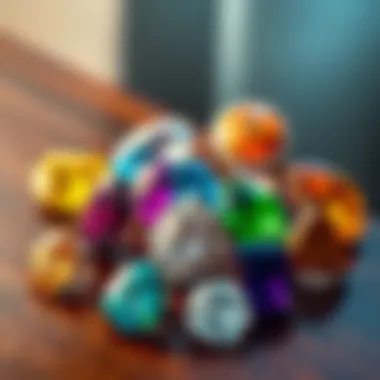
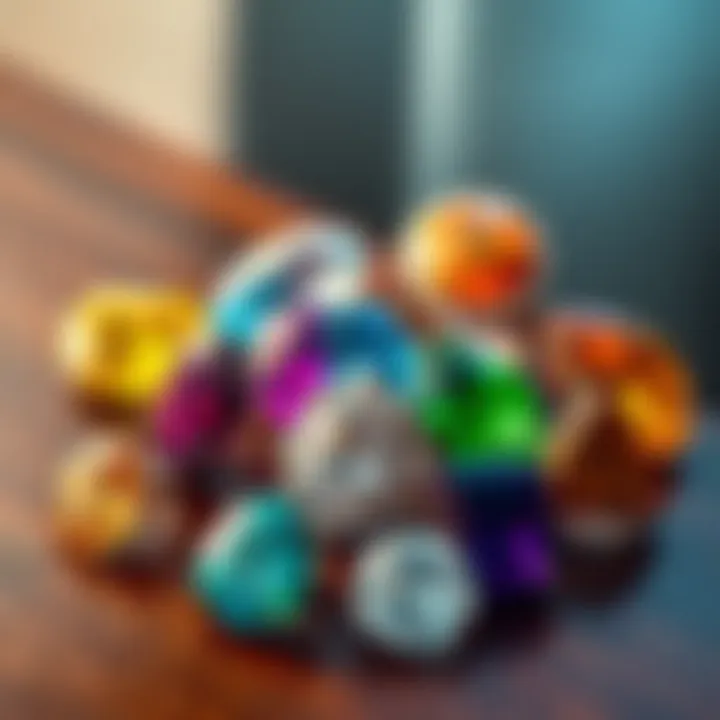
Choosing an engagement ring also encompasses deeply personal interpretations. For some, it represents a milestone—a tangible reminder of love and commitment. Couples may wish to incorporate stones that hold personal significance, such as birthstones or gemstones that relate to shared experiences. This approach transforms what's typically a standard purchase into a highly personal gesture of affection.
"An engagement ring is not just a ring; it is a promise, a future, and a love story etched in time."
Furthermore, the ring can signify personal style, allowing couples to express their identity and story through the choice of metal, stone, and design. When purchasing, it is essential to reflect not only on societal expectations but on what truly resonates on an individual level.
Establishing a Budget
When embarking on the journey to find the perfect engagement ring, establishing a budget is arguably one of the first, and most crucial, steps. It's easy to let excitement sweep you off your feet, but without a clear budget, you may find yourself in a tight spot or even worse—unhappily looking at rings you can't afford. A well-defined budget not only helps set realistic expectations but can also foster a more satisfying engagement ring shopping experience.
Setting Realistic Expectations
Creating a budget allows you to align your desires with financial realities. It's vital to consider personal financial situations, lifestyle choices, and future plans; what you want might not always match what you can spend.
Talk with your partner, or even confide in trusted family members to gauge expectations. Think about what they appreciate in terms of jewelry style and value. Is it the size of the stone or the uniqueness of the design that stands out to them? Discussing these elements can help you modulate expectations based on your budget. Moreover, it sets the stage for both parties to agree on something meaningful. Remember, an engagement ring is not just a piece of jewelry; it should encapsulate a shared commitment and understanding.
Cost Factors to Consider
Determining a budget hinges on understanding the various costs associated with engagement rings. Here are a few factors that heavily influence the overall price:
- Metal: The type of metal can significantly affect costs. Platinum, for example, tends to be more expensive than gold or silver.
- Stone Quality: Factors such as cut, clarity, color, and carat weight in diamonds or gemstones directly influence their cost. The finer the quality, the heftier the price tag.
- Design Complexity: A custom design or a ring with intricate detailing often commands a higher price.
- Brand Origins: Rings from well-known designers or brands may also bear higher costs, reflecting their reputation in the market.
Taking time to research the market can yield a wealth of insights, and there’s no harm in setting realistic priorities. Focus on what really matters to you and your partner—whether that means investing in a quality stone or opting for a breathtaking design that speaks to shared experiences.
Financing Options
If your heart is set on the perfect ring but your wallet isn't quite ready to cooperate, don't fret. Financing options exist that can help ease some of the financial strain. Here are a few avenues worth exploring:
- Layaway Plans: Many jewelers offer layaway plans wherein you can reserve a ring by making a series of payments over time.
- Credit Financing: Store-branded credit cards or personal loans can be viable options, but it’s crucial to read the fine print and ensure you understand any interest rates involved.
- Zero-Interest Financing: Some jewelers offer zero-interest financing for a defined period, allowing you to spread out payments without accruing additional costs.
Though financing can help secure a beautiful engagement ring now, be sure to weigh your options carefully to avoid falling into debt. As the saying goes, "don’t bite off more than you can chew." By establishing a sensible budget and exploring these options, you’ll be prepared to find a ring that meets both your desires and financial reality.
Remember, the goal is to find a ring that embodies your commitment, not one that stretches your finances to the brink.
Choosing the Right Metal
Selecting the right metal for an engagement ring is as crucial as picking the right gemstone. The metal doesn’t just hold the stone; it shapes the overall look and feel of the ring, influencing its durability, color, and style. Understanding the characteristics of various metals helps buyers make an informed decision, which ultimately reflects personal taste and lifestyle.
Traditional Gold
Yellow Gold
Yellow gold has stood the test of time and remains a beloved choice. Its warm, rich hue complements a variety of skin tones and adds a classic vibe to any piece of jewelry. Many people appreciate yellow gold for its natural color and luster.
A unique feature of yellow gold is that it is alloyed with metals like copper and zinc, which contributes to its resilient nature. The malleability of yellow gold also makes it easier to engrave, allowing for personal touches which many couples desire. However, it’s worth noting that yellow gold may require more maintenance, as it can scratch and tarnish over time.
White Gold
White gold offers a more contemporary look with its sleek silvery appearance. This metal is often coated in rhodium, which not only enhances its shine but also adds a layer of protection against scratches and tarnishes. The modern feel of white gold appeals to many couples, especially those looking for a minimalist style.
The downside is that rhodium plating can wear off over time, requiring re-plating to maintain its look. This factor may not sit well with buyers looking for minimal upkeep. Still, white gold’s elegance and compatibility with various gemstone colors makes it a top contender for many.
Rose Gold
Rose gold, with its unique pinkish hue, has surged in popularity in recent years. Often associated with romance and warmth, this metal has become a favorite among couples seeking something slightly different. One of its key characteristics is its copper alloy content, which gives rose gold its distinctive color.
A standout feature of rose gold is its ability to complement both traditional and modern styles, making it versatile. Yet, similar to yellow gold, it can scratch more easily. Buyers should also consider potential allergy issues since some people have sensitivities to copper. Overall, rose gold offers charm and personality—qualities that many aspire to convey through their engagement ring.
Alternative Metals
Platinum
Platinum is a heavy hitter in the world of engagement rings. Known for its durability and hypoallergenic properties, platinum does not corrode or tarnish, making it one of the most admired choices. This metal can handle daily wear without compromising its integrity.
One of its profound characteristics is its natural white shine, which does not require additional plating. However, its cost can be a sticking point for some. Despite the higher price tag, many view platinum as an investment due to its longevity and timeless appeal.
Palladium
Palladium is another metal that’s gaining traction as an alternative. Like platinum, it is also hypoallergenic and has a natural silvery-white color that appeals to many buyers. It is lighter than platinum, which can be beneficial for those who prefer a less cumbersome ring.
However, palladium is less dense than platinum, which means the metal can be more prone to scratches. This factor might concern couples intending to wear their rings daily. Nevertheless, palladium is often more budget-friendly while still offering a luxurious finish.
Sterling Silver
While sterling silver is often considered a budget option, it holds its own in the ring market. The metal has a bright, shiny finish and is less expensive than many of its counterparts, making it an attractive choice for individuals on tighter budgets. It’s also lightweight and comfortable for everyday wear.
A key characteristic of sterling silver is its requirement for regular maintenance to prevent tarnishing. Unlike gold and platinum, it can tarnish more easily, necessitating frequent cleaning. Buyers should keep this in mind, evaluating if they are willing to put in the effort for upkeep. Overall, sterling silver can be a lovely option for those prioritizing affordability without sacrificing style.
When choosing metal for an engagement ring, consider not just the aesthetic, but also the durability and care involved.
Evaluating Gemstone Options
Choosing the right gemstone is one of the most critical steps when it comes to selecting an engagement ring. Different gemstones offer diverse aesthetics, meanings, and values, making this decision both exciting and daunting. It’s not merely about what sparkles; it’s about finding the stone that resonates with personal taste and expresses the love shared between partners.
When considering gemstones, two major categories come into play: diamonds and alternatives. Diamonds, often associated with enduring love, are the traditional choice. However, alternative gemstones like sapphires, emeralds, and moissanites are increasingly capturing attention for their unique beauty and potential advantages. Knowing the various options and their respective qualities can lead to a more informed and satisfying choice.
The Diamond Quality Factors
Cut
The cut of a diamond is often considered the most important factor. This aspect determines how well the stone reflects light, which is crucial for its brilliance and sparkle. A well-cut diamond exhibits a higher level of fire—those little flashes of colorful light—making it visually captivating.
It's not just about how the diamond looks; the precision of the cut impacts value as well. An ideal cut can dramatically enhance a gem’s appeal. However, achieving the perfect cut is a more arduous process for jewelers, and thus, fine cuts typically come with a heftier price tag. But in terms of the overall experience of wearing and flaunting the ring, many find a little extra investment in cut entirely worth it.
Color
While diamonds are often celebrated for their clarity, the color grade is essential too. Color in diamonds refers to the presence of any tint within the stone. Colorless diamonds fetch higher prices due to their rarity. Yet, subtle shades can sometimes provide a unique charm.
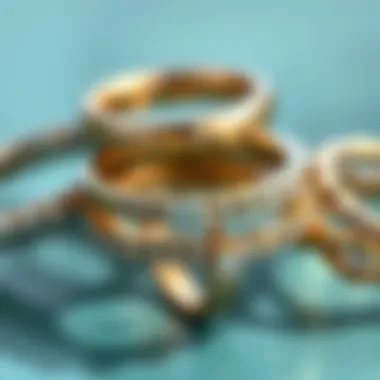
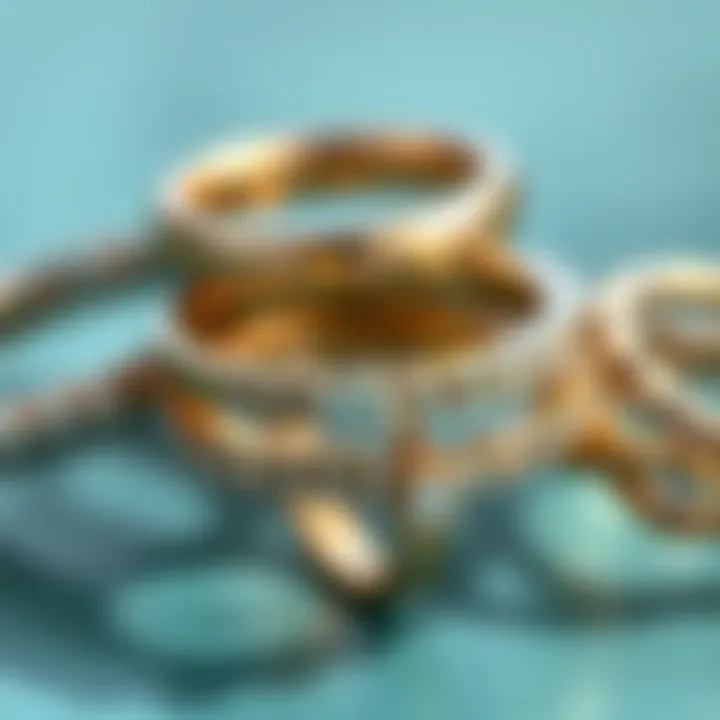
Some couples may opt for stones that are faintly colored, such as slightly tinted diamonds, which can often be more cost-effective while still exhibiting beauty. One consideration is that a diamond's appearance varies under different light sources. Natural daylight might exhibit colors differently than dim indoor lighting. Hence, examining diamonds under various lighting is crucial in this decision-making process.
Clarity
The clarity of a diamond refers to the presence of imperfections—internal or external. These might include flecks or tiny inclusions that can affect its overall radiance. A clearer diamond will reflect light more efficiently.
Many buyers find themselves in a maze of clarity options, usually numbered from Flawless (FL) to Included (I). While higher clarity is considered more desirable, those with minor inclusions can often go unnoticed to the untrained eye. This trait may present an opportunity for cost savings while still presenting a lovely stone that reflects personal sentiment, rather than just a high price point.
Carat Weight
Carat weight, the measurement of a diamond's size, is a significant factor affecting overall cost. Larger stones are undeniably eye-catching and tend to be valued more highly. However, greater carat weight does not necessarily equate to better quality. The overall appearance can sometimes be affected by cut, color, and clarity.
To squeeze the most value out of your budget, consider opting for a somewhat smaller carat weight. Selecting a stone with an excellent cut and good clarity can yield a visually larger-looking diamond without the higher costs associated with bigger carats. Modern jewelers have also crafted methods to make diamonds appear larger, providing additional options for cost-conscious buyers.
Alternative Gemstones
Sapphires
Sapphires are a striking alternative to traditional diamonds, known for their rich blue hues. However, they also come in various colors, offering versatility that allows them to pair beautifully with different styles of settings. Considered a stone of wisdom and royalty, sapphires can convey deep meaning beyond their aesthetic appeal.
One practical benefit of sapphires lies in their durability. They rank a 9 on the Mohs hardness scale, making them resistant to scratches and suitable for everyday wear. However, it's crucial to double-check whether the stone has undergone treatment, as many sapphires on the market have been enhanced in some form.
Emeralds
Emeralds, with their lush green shades, offer a vivid and classic charm. Their deep color can symbolize rebirth and love, lending them a special significance in engagement rings. However, these stones typically exhibit inclusions known as "jardin," which may influence clarity and enhance the stone’s character.
Emeralds also tend to be softer, ranking about 7.5 to 8 on the Mohs scale, which means they require more care in daily wearing. Still, their unique elegance and vividness often outweigh the need for careful handling, making them an enticing option for those with a taste for the unique.
Moissanite
Moissanite has gained popularity due to its brilliance and affordability. It mimics the appearance of diamonds remarkably well while often costing considerably less. One remarkable characteristic of moissanite is its fire; it displays more rainbow-like flashes than typical diamonds, which captivates many buyers.
However, being synthetic, some may see moissanite as an undesirable compromise compared to natural stones. Understanding your partner’s preference between natural and lab-created can help make this choice clearer. Still, its affordability and breathtaking beauty make moissanite a strong competitor in the engagement ring market.
Ultimately, evaluating gemstone options is not solely about aesthetics or budget but also reflects personal values, sentiments, and lifestyle considerations.
Understanding the Styles of Engagement Rings
When it comes to engagement rings, the style is a defining feature. Choices reflect personal taste and can convey the uniqueness of the relationship. Not only does the design convey a specific aesthetic, but it also contributes to the overall message of love and commitment. Understanding various styles is essential for making an informed decision that resonates with both partners.
Classic vs. Modern Designs
Classic designs often evoke a timeless elegance that many cherish. Think of the solitaire setting, where a single stone stands tall and proud, emphasizing its beauty and brilliance. This style’s key benefit lies in its versatility; it pairs seamlessly with any outfit, be it a casual brunch or an extravagant gala. However, the modern designs have emerged as crowd-pleasers too. They often play with unconventional shapes and asymmetric settings, appealing to those desiring something different. An evolving trend, modern designs can feature more than one stone, adding layers of meaning and beauty to tell a couple’s unique story.
Setting Types
The setting of a gemstone is crucial for how its beauty is displayed. There are three prominent settings that stand as definitive choices for many:
Prong Setting
The prong setting is perhaps the most common among engagement rings. It involves small metal prongs that hold the gemstone securely in place. This style allows for maximum light exposure, enhancing the stone's brilliance. The key characteristic of prong settings is simplicity—allowing the centerpiece to truly shine without distraction.
Advantages:
- Enhanced Sparkle: The exposed facets of the stone catch light effortlessly, resulting in a vibrant sparkle.
- Variety: Prong settings can accommodate various shapes and sizes of stones, proving beneficial in expressing personal style.
However, one must consider potential downsides as well. The exposed stone may be more susceptible to damage or snagging on fabrics. Careful attention to maintenance is necessary to ensure longevity.
Bezel Setting
The bezel setting takes a different approach, wrapping the gemstone in a metal rim that not only secures it but also provides a sleek look. This style is known for its durability, making it a preferred choice for those who lead active lifestyles. The significant aspect of a bezel setting is its modernity, giving a fresh twist to the traditional ring style.
Advantages:
- Security and Safety: The stone is more securely set, reducing the chances of losing it.
- Contemporary Appeal: Its clean lines and sleek design resonate well with those favoring modern aesthetics.
One of the drawbacks, however, is the reduction of brilliance when compared to prong settings, as the metal can obscure some portions of the stone.
Channel Setting
Channel settings involve a row of stones set in a groove within the band. This style creates a continuous line of sparkling gems, embodying a sense of unity and flow. The hallmark feature of the channel setting lies in its seamless appearance, as the stones are nestled closely together, providing a contemporary and chic look.
Advantages:
- Low Profile: The stones are flush with the band, making them less prone to damage, ideal for everyday wear.
- Stunning Array of Stones: It allows the incorporation of multiple smaller stones, adding depth and character to a ring without overwhelming the design.
However, if one stone chips or becomes damaged, it can sometimes be difficult and costly to replace, leading to considerations for long-term care.
Understanding the different styles and settings helps potential buyers navigate the often overwhelming choices available. Each element offers its own beauty and significance, essential for a ring that fits not only the finger but also the soul of the person wearing it.
Choosing the Right Ring Size
Choosing the right size for an engagement ring is not just a matter of comfort; it's a pivotal element of the entire ring purchasing experience. An ill-fitting ring can lead to a plethora of problems, from discomfort in wearing to the potential loss of the ring altogether. Understanding one's ring size ensures the engagement ring enchants and delights, reflecting the love and thought that goes into the selection. The wrong size may cause an otherwise perfect piece to feel out of place or unwearable, tarnishing this joyous moment. Thus, determining the right size should sit high on your priority list.
Methods for Sizing
When it comes to figuring out the right ring size, various methods can be employed. Here are several that can help you nail it down:
- Visit a Jeweler: Most jewelers offer free ring sizing services. This is often the most accurate way, where a professional measures the finger with precision.
- Use a Ring Sizer: Jewelers may provide plastic or metal ring sizers that can be slipped onto fingers. This method can help determine the size based on the snug fit.
- Measure with a String or Paper: If visiting a jeweler isn't an option, a piece of string or a strip of paper can be artfully wrapped around the base of the finger. Mark where it overlaps, then measure that length with a ruler. Make sure to convert the measurement into the standard ring size.
- Find an Existing Ring: If the person who will wear the ring already has a well-fitting ring, measuring its inner diameter can give a solid baseline for size. Just be careful – not all fingers are the same!
Considerations for Future Adjustments
Sizing is not only about the immediate need; future adjustments can play a crucial role in ensuring long-term satisfaction with the ring. Here are some things to keep in mind:
- Predicting Changes: People’s fingers can swell due to weight changes, weather conditions, or even hormonal shifts. Recognizing this might lead to erring on the side of a slightly looser fit.
- Ease of Sizing: Different types of rings can be resized in varying degrees. Simple bands made of gold or platinum tend to be easier to adjust. In contrast, rings with intricate designs or settings may be more complicated, making it important to consider how much resizing might be needed down the line.
- Seasonality Effects: Fingers tend to swell during warm months and shrink when it’s chilly. Finding that sweet spot where the ring fits well year-round can be important.
- Budget for Adjustments: If you're leaning towards a more complex design, factor in potential resizing costs when drafting your overall budget.
In summary, finding the right ring size involves straightforward methods and careful consideration for what's ahead. This step, often overlooked, can make a world of difference in the engagement experience, turning a beautiful piece of jewelry into a beloved treasure.
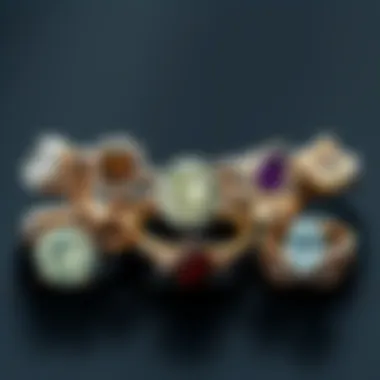
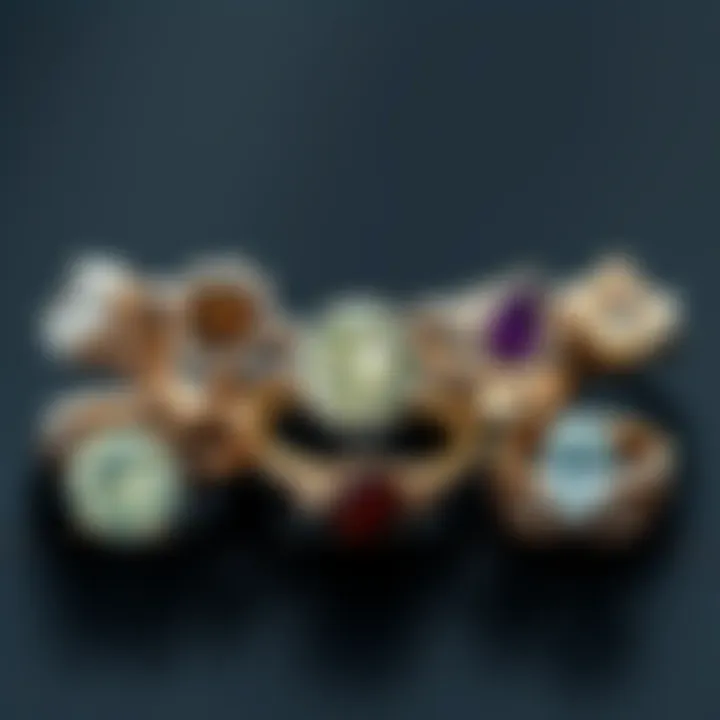
Exploring Ethical Considerations
When it comes to purchasing an engagement ring, the ethical implications of one's choices can't be overlooked. In a world where consumers increasingly seek to align their values with their purchases, understanding the ethical landscape around jewelry is essential. This section delves into two pivotal areas that buyers should consider: sourcing conflict-free stones and sustainable practices.
Sourcing Conflict-Free Stones
The term "conflict-free" refers to gemstones that have been sourced without financing armed conflict or human rights violations. The diamond industry, in particular, has been scrutinized for its historical ties to warfare and exploitation, especially in regions like Sierra Leone and the Democratic Republic of the Congo. Here, diamonds have been called "blood diamonds" as they fund violence and suffering.
- Certification Bodies: Organizations like the Kimberley Process aim to prevent trade in conflict diamonds through certification. When buying an engagement ring, checking for certification from reliable bodies is vital. Buyers should ask jewelers for evidence of a gem's origin.
- Traceability: Forward-thinking companies are offering transparency by tracking their stones from mine to market. This kind of traceability ensures that consumers are investing in ethically sourced gems.
- Lab-Created Alternatives: The rise of lab-grown diamonds offers a guilt-free option. These stones are chemically identical to natural diamonds but created under controlled conditions, often with lower environmental impacts.
Utilizing the knowledge that conflict-free stones exist can positively influence your decision and foster a more responsible jewelry market. The ethical standpoint of sourcing these stones reflects a commitment to supporting human rights and sustainable livelihoods.
Sustainable Practices
Sustainability in the jewelry industry extends beyond the stones used; it also encompasses how the entire supply chain operates. Companies with a focus on sustainability are mindful not only of the materials they use but also their environmental footprint.
- Recycled Metals: Many jewelers now offer engagement rings crafted from recycled metals. This process reduces the need to extract new raw materials, which can harm ecosystems. Plus, using previously sourced metals helps decrease the market demand for newly mined materials.
- Responsible Mining: For those opting for natural gemstones, it is critical to understand how the materials were mined. Jewelers who prioritize sourcing from mines that adhere to ethical labor and environmental standards contribute positively to both the local economy and the planet.
- Social Responsibility Initiatives: Some brands engage in community development projects throughout the regions where they source materials. This can include funding local schools or healthcare facilities, promoting better living conditions for those involved in the mining process.
"The choices we make in purchasing gemstones can either support ethical practices or perpetuate a cycle of harm. It’s important to be aware of where our jewelry comes from and who is affected."
Incorporating sustainable practices into your engagement ring selection not only enriches your own experience but also contributes to a larger, positive change in the jewelry industry. By purchasing from businesses that prioritize ethics and sustainability, buyers can feel satisfied in their choices while making a tangible difference in the world.
By being informed about these considerations, you're better equipped to make a decision that aligns with your values while celebrating love and commitment.
The Importance of Certification
When venturing into the realm of engagement rings, the importance of certification cannot be overstated. Certification serves as a testament to the quality and authenticity of the gemstone. For those investing a significant amount of money, understanding this aspect is crucial. Without a reliable certification, consumers may be left in the dark regarding what they are actually buying—potentially making a purchase that is far from what was promised.
Understanding Gemstone Certification
Gemstone certification is a process where a professional gemological laboratory evaluates a stone based on predetermined criteria. These labs, such as the Gemological Institute of America (GIA) or the American Gem Society (AGS), issue reports that detail vital information about the gemstone. This includes specifics like cut, color, clarity, and carat weight.
- Credibility: A certified stone gives buyers confidence in the authenticity of their purchase. It is akin to having a seal of approval, ensuring that what you're getting matches what is advertised.
- Value: A certificate also helps determine the stone's market value, serving as an important reference point for reselling purposes.
- Education: Understanding the report can serve as an educational tool, allowing buyers to make informed choices by deeply comprehending what all the grading terms mean.
In an age overflowing with options, being equipped with a certification helps you separate the wheat from the chaff, ensuring you know exactly what you are getting.
Choosing Reputable Grading Systems
Not all certification systems are created equal. It’s important to differentiate between reputable grading systems and those that may lack credibility. When shopping for an engagement ring, look for certifications from recognized institutions, as these organizations have rigorous standards in place.
"A diamond without a certificate is like a car without a title; it's hard to be sure it truly belongs to you."
- Gemological Institute of America (GIA): Known worldwide for its strict grading standards, GIA is one of the most trusted names in gemstone certification. It focuses on education and accurately represents gemstone attributes.
- American Gem Society (AGS): AGS is another credible institution that emphasizes ethical practices and membership based on a commitment to quality.
- International Gemological Institute (IGI): While also reputable, the IGI is often seen as less strict compared to GIA or AGS. Still, it can be an acceptable choice, especially for alternative gemstones.
In assessing certification, remember that quality matters. A credible grading system not only adds value to your ring but also peace of mind to your investment. By choosing a certified gemstone, you secure more than just a piece of jewelry; you invest in a tangible assurance of quality and integrity.
Where to Purchase Engagement Rings
When it comes to acquiring an engagement ring, the options for purchasing seem abundant. However, where you choose to buy can significantly influence the quality, cost, and overall experience of your purchase. The engagement ring symbolizes more than just a piece of jewelry; it stands for commitment and love. Therefore, finding the right retailer, whether online or in a physical location, is essential to ensure you make an informed choice that meets your expectations.
Online vs. Brick-and-Mortar Stores
In today’s digital age, the choice between shopping online and visiting a brick-and-mortar store can feel like a tug-of-war. Both avenues have their unique advantages and drawbacks, making it crucial to weigh your options carefully.
Online Shopping can be a treasure trove of opportunities. You can browse countless styles, compare prices with ease, and read reviews from other buyers—much like shopping at a bigger marketplace. Furthermore, many online retailers provide extensive information about their products, including detailed photos and certification details. However, there’s a catch. One can’t physically inspect the ring before making a purchase. This might lead to surprises once the ring arrives. Moreover, the return process could sometimes be a hassle.
Brick-and-Mortar Stores, on the other hand, offer the tactile experience of trying on rings and observing the craftsmanship in person. You can speak directly with knowledgeable sales staff who can answer your questions and assist you in understanding qualities like gemstone grading and settings. Still, the range of options may be limited compared to online offerings, and prices can vary widely depending on the local market.
In choosing between these two, you might consider starting your journey online for research, then visiting a store to experience the rings firsthand. This way, you can enjoy the best of both worlds: a broad understanding of what’s out there coupled with the authentic experience of touching and trying on rings.
Evaluating Seller Reputation
No matter where you decide to purchase, scrutinizing the seller’s reputation can’t be overstated. A solid reputation often reflects the quality of product and service you can expect to receive. To evaluate a seller's reliability:
- Look for Reviews: Websites like Yelp and Trustpilot can provide insights from previous customers. Positive feedback or negative signals can help you gauge how they handle sales and post-purchase interactions.
- Check Certification: Ensure that the seller provides certification from reputable grading laboratories for any gemstones they sell. These certifications add legitimacy to the seller’s claims about the quality of the stones.
- Customer Service: Reach out to the retailer with questions. A responsive attitude can be a good indicator of a seller’s commitment to customer satisfaction.
- Return Policies: Verify their return policies before purchasing. Flexible return policies reflect confidence in their products and protect you in case the ring doesn’t meet your expectations.
Ultimately, investing time in verifying the seller’s reputation can save you from potential headaches later and help ensure that your engagement ring is a joyous embodiment of your personal story.
"The right store can turn the purchase of an engagement ring into more than a transaction; it can create a memorable milestone in your love story."
For more information on how to evaluate jewelers, you may want to check resources like Gemological Institute of America or insights on buyer experiences on Reddit (reddit.com).
After the Purchase: Care and Maintenance
Once you've chosen the perfect engagement ring, the journey doesn't stop there. Maintaining its beauty and integrity is just as important as selecting it initially. Understanding the care and maintenance required can preserve your ring for generations, enhancing its emotional and monetary value.
Cleaning and Storage
Regular cleaning and proper storage are essential practices that can keep your engagement ring looking as dazzling as the day you first slipped it on your partner’s finger. Regularly inspecting the ring for any signs of wear or damage is a good habit to develop.
Cleaning the Ring
Keeping your engagement ring clean is paramount. Dust, grime, and lotions can diminish its shine. Many jewelers recommend a simple cleaning method involving a gentle soap and warm water solution. Here's how to do it:
- Mix warm water with a few drops of mild dish soap.
- Soak your ring for about 15-20 minutes.
- Use a soft-bristled toothbrush to gently scrub any hard-to-reach areas.
- Rinse under lukewarm water and dry with a soft cloth.
However, be mindful that harsher chemicals found in household cleaners and abrasive fabrics can damage your ring. For a more thorough clean, it’s wise to bring it to a professional jeweler.
Storing the Ring
When not being worn, how and where you keep your ring is crucial. Storing it in a soft cloth or a designated ring box can prevent scratches and damage from other jewelry. If you have a multi-piece set, avoid tossing them into one compartment where they can collide with each other.
Something to keep in mind is the environment in which you store the ring. Humidity and extreme temperatures can also affect the integrity of certain metals and stones. Keeping your ring in a climate-controlled area, away from direct sunlight, is ideal.
Insurance Considerations
Insuring your engagement ring is a practical step to take after making such a significant investment. Just like home or auto insurance, having a separate policy for your ring can offer peace of mind should the unexpected occur. You might ask: why should I insure an engagement ring? Here are a few reasons:
- Protection from Loss or Theft: While we’re all hopeful that nothing will happen to our precious items, the reality is that theft and loss can occur. An insurance policy can cover replacement costs, making it easier to recover from such an event.
- Accidental Damage: Rings can chip, bend, or even break due to everyday wear. Insurance often covers these incidents as well, allowing for repairs or total replacement without a substantial financial burden.
- Valuation: Getting your ring appraised by a certified jeweler is often required for many insurance policies. This not only assists with accurate coverage but also provides you with a documented history of your piece, which can be valuable should you decide to sell it in the future.
When searching for insurance, look for a policy that offers comprehensive coverage for the specifics of your ring. You might also want to consider getting scheduled coverage that lists the ring separately, ensuring full value without any deductible in case of a claim.
Be proactive; often, it's not just about finding the perfect ring but safeguarding it for a lifetime.







